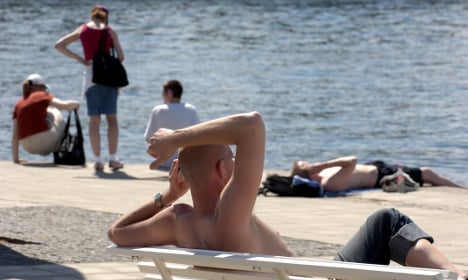For 40 years we have been taught to avoid the sun in order to reduce the risk of malignant melanoma skin cancer. But new findings show that avoiding exposure to the sun, on the contrary poses a major health risk.
We believe that those who campaign for “the less sun, the better” take large responsible for our health. Those who follow this advice seem to shorten their life expectancy by half-a-year to two years.
There have been three great lifestyle factors that are strongly related to illness and death: smoking, inactivity and obesity.
Our research indicates that people who are both non-smokers and non-sunbathers have the same risk of death as those that are both smokers and sunbathers. Avoiding the sun thus puts you at as great a risk of dying as smoking does.
We also find that women who avoid the sun double their risk of cardiovascular diseases such as heart attacks, strokes and blood clots. Twice as many who don't sunbathe also contract “other” illnesses, such as diabetes, multiple sclerosis and lung disease.
In all likelihood, people who live in the Nordic countries have become pale because it gives them an advantage. In terms of nature, it is the “survival of the fittest”.
If you listen to the debate, you are led to believe that it is dangerous to be pale or sensitive to the sun. Redheads are, however, probably the ones best suited to a sun-starved life in Scandinavia.
Sun-sensitive and fairskinned people likely need less sun for their health, and should be outside in the sun a shorter amount of time before they cover themselves up. Sunscreen “protection” is not a good idea.
It is likely that sunscreen eliminates the skin's reaction to too much sun, but does not significantly protect against melanoma. The price for sun-sensitive people's adaption to a sun-starved environment is that the risk of melanoma increases at over-exposure to the sun.
There is no scientific study that shows that you can be outside in the sun longer with sunscreen, in terms of the risk of melanoma. In Sweden, we see that sunscreen users double their risk of melanoma, most likely because they have spent too much time in the sun.
We share the same concern as the Swedish Radiation Safety Authority (Strålskyddsmyndigheten) that 80 percent of Swedes feel safe in the sun after applying sun lotion. Changing this way of thinking is key when it comes to decreasing the rate of malignant melanoma.
One thing many guidelines for sunbathing have had in common is that they have been poorly founded in science. Some campaigns have, on the contrary, helped create wrong and unhealthy sunbathing habits.
In 1992 a campaign was run in Sweden called “how to sunbathe safely”. It advised that you should “use sunscreen with a high sun protection factor (SPF) at first (…) then slowly increase the number of hours in the sun from one hour a day to five, six”.
This sort of advice likely contributes to both the wrong way of thinking and a large increase of melanoma in Sweden. You should/cannot stay out in the sun for longer time with sunscreen. After you have received a “lagom” dose of sunshine (preferably without sunscreen) you should seek the shade or get dressed.
So what can we do to get the sun we need without increasing the risk of melanoma?
The melanoma risk increases when you over-tan (for example spend too much time in the sun with sunscreen), get burned (get blisters and so on) and during exaggerated use of sunbeds. At the same time we know that those who work outside do not increase their risk of melanoma. Daily exposure to the sun thus does not increase the risk of melanoma.
Our advice is that famous Swedish word 'lagom' [meaning average or just right]. Sunbathe 'lagom' every day.
A 'lagom' start is having your lunch coffee in the sun. Then it will be every day, in the middle of the day when you enjoy the best rays – and not too long.
This article was written by doctors Pelle Lindqvist, who works at the women's hospital in Huddinge, and Håkan Olsson, from the oncology department in Lund. It was first published in Swedish by SVT.



 Please whitelist us to continue reading.
Please whitelist us to continue reading.